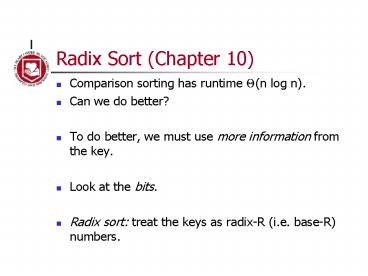Radix Sort Chapter 10 - PowerPoint PPT Presentation
1 / 10
Title:
Radix Sort Chapter 10
Description:
... treat the keys as radix-R (i.e. base-R) numbers. Sorting Zip Codes ... How would you sort a set of zip codes in O(n) time? use 10 buckets to accumulate items ... – PowerPoint PPT presentation
Number of Views:218
Avg rating:3.0/5.0
Title: Radix Sort Chapter 10
1
Radix Sort (Chapter 10)
- Comparison sorting has runtime Q(n log n).
- Can we do better?
- To do better, we must use more information from
the key. - Look at the bits.
- Radix sort treat the keys as radix-R (i.e.
base-R) numbers.
2
Sorting Zip Codes
- How would you sort a set of integers in the range
0..9 in O(n) time? - use 10 buckets (linked lists) to accumulate the
items. - How would you sort a set of zip codes in O(n)
time? - use 10 buckets to accumulate items
- sort once for digit 5 (least significant), then
4, then 3, then 2, then 1. (LSD sort) - note that each stage must be stable
- (you can sort from left to right (MSD) if you are
clever.) - Sorting machines for punched cards
3
Radix Sort Utilities
- We need to be able to get a chunk out of a key.
- inline int digit(int a, int digit, int radix)
return (a / pow(radix,digit)) radix - It could be a fixed number of bitsoften thats
fastest. - const int bitsword 32 bitschunk 4
- const int chunksword bitsword/bitschunk
- const int radix 1 ltlt bitschunk
- inline int digit(long a, int b) return (a gtgt
bitschunk(chunksword-b-1)) (radix-1)
4
Binary Quicksort
- How about using bits as pivots for quicksort?
- move all numbers starting with bit 0 before those
starting with bit 1 (like a Quicksort partition
on 10000) - recursively sort each half on bit 2, each quarter
on bit 3,
5
Binary Quicksort Runtime?
- b passes, where b is the number of bits per word
- O(n) time per pass
- O(b n) O(n) worst case
- but in practice its worse than quicksort high
constant. - actually, you may not even have to look at all
the input bits! - but what happens if we sort many small number?
6
MSD Radix Sort
- Like binary quicksort but with larger chunk
size - But how can we move items intothe correct place
in one pass? - Need to count the number of items starting with
a, b, c, etc. - Then we can move items into place in one pass.
- (Hmmm, lets seethe place for the first c word
will be after all the a and b words)
7
MSD Radix Sort code
- define bin(A) 1countA
- template ltclass Itemgt
- void radixMSD(Item a, int l, int r, int d)
- int i, j, countR1
- static Item auxmaxN
- if (d gt bytesword) return
- if (r-1 lt M) insertion(a, l, r) return
- for (j0 jltR j) countj 0
- for (il iltr i) countdigit(ai,d)1
- for (j1 jltR j) countj countj-1
- for (int il iltr i)
- auxcountdigit(ai,d) ai
- for (il iltr i) ai auxi-l
- radixMSD(a, l, bin(0)-1, d1)
- for (j0 jltR-1 j)
- radixMSD(a, bin(j), bin(j1)-1, d1)
8
LSD Binary
- If we work from right to left what changes?
- Just do a stable pass for each bit!
9
LSD Radix Sort
- Like LSD Binary sort but on bigger chunks of
the key. - We still need to count the number of each type to
figure out where to move items in one pass - Runtime is still O(n).
10
LSD Radix Sort -- code
- template ltclass Itemgt
- void radixLSD(Item a, int l, int r)
- static Item auxmaxN
- for (int d bytesword-1 dgt0 d--)
- int i, j, countR1
- for (j0 jltR j) countj 0
- for (il iltr i) countdigit(ai,d)1
- for (j1 jltR j) coutj countj-1
- for (il iltr i)
- auxcountdigit(ai,d) ai
- for (il iltr i) ai auxi-l































